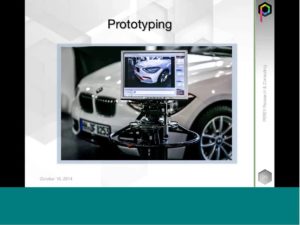Metaio Reveals 3D Depth Sensor Support for SDK 6
Metaio unveiled a few new details about the Metaio SDK 6 – support for 3D depth-sensing camera systems.
Metaio unveiled a few new details about the Metaio SDK 6 – support for 3D depth-sensing camera systems.
“Augmented reality user interfaces are going to be huge if someone can finally deliver a system that is usable,” says Bo Brinkman of Miami University. So what does Magic Leap have that makes it so valuable to Google and Qualcomm? Bloomberg.tv conducts a video interview with the director of the Augmented Reality Research Center.

The IEEE-SA hosted webinar about Augmented Reality in Manufacturing introduces the topic by explaining the role of information technology in modern manufacturing. The 9 areas of potential value to companies introducing AR in manufacturing include:
Watch the archive of this Webinar to learn more.
The Khronos Group has released the OpenVX specification for accelerating computer vision assisted algorithms. Information about the new specification is available on the Khronos Group site.
In their design laboratory doctors and psychologists at the Virtual Reality Medical Center are working on ways to blend simulated medical interventions with Augmented Reality systems to enhance the immersive quality of the activity.
Essentially, VRMI is seeking to use AR to train soldiers and keep them from freezing up in stressful situations. Wiederhold and his colleagues have shown that the lessons they’ve learned from using VR and AR treatment for PTSD can be applied proactively to soldiers before they enter combat, effectively making them immune to combat stress in the same way that a flu shot can keep you from getting sick. Learn more by reading the article and watching the video below.
The global head mounted display market is expected to reach USD 11,793.3 million by 2020. Read this study published by Grand View Research to learn more.
Panasonic Factory Solutions Company of America offers an extension for its PanaCIM Enterprise Edition platform. Using the Maintenance Augmented Reality module in the factory management can keep track of maintenance. The web site and the brochure provide glimpses at the potential of Augmented Reality however, lack detail.

In this interview with Augmate CEO and founder, Pete Wassell, he describes his vision for AR in the workplace. Read the blog post to learn how Augmate plans to address the barriers. Watch the video to see the Augmate solution in the warehouse.
Collaborative use cases will be important in enterprise AR, however, the user experience is likely to be confusing and difficult to master. Microsoft Research staff members Andy Wilson and Hrvoje Benko presented the Mano-a-Mano project at the ACM User Interface Software and Technology conference.
Mano-a-Mano is a unique spatial augmented reality system that combines dynamic projection mapping, multiple perspective views and device-less interaction to support face to face, or dyadic, interaction with 3D virtual objects. Its main advantage over more traditional AR approaches, such as handheld devices with composited graphics or see-through head worn displays, is that users are able to interact with 3D virtual objects and each other without cumbersome devices that obstruct face to face interaction. Read the full ACM UIST article for more details.
There are many excellent use cases for use of hands-free displays for information delivery and capture in transportation industry. Whether it is a map showing directions to an entry point, special delivery instructions, a video confirming a successful delivery or instant feedback about productivity and performance, these can all increase efficiency. However, safety with hands-free displays is a burning issue for which there are few clear solutions. Read more about the opportunities and obstacles in David Upton’s post on IT Pro Portal